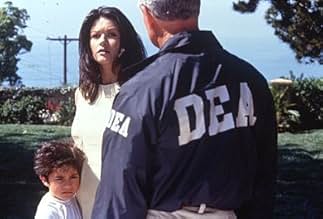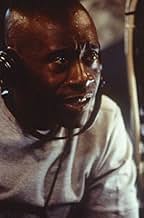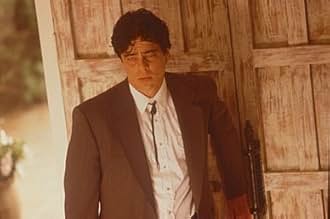Traffic
Un juge conservateur est nommé par le président des États-Unis pour mener une guerre acharnée contre la drogue. Il découvre ensuite que sa fille adolescente est toxicomane.Un juge conservateur est nommé par le président des États-Unis pour mener une guerre acharnée contre la drogue. Il découvre ensuite que sa fille adolescente est toxicomane.Un juge conservateur est nommé par le président des États-Unis pour mener une guerre acharnée contre la drogue. Il découvre ensuite que sa fille adolescente est toxicomane.
- Réalisation
- Scénario
- Casting principal
- Récompensé par 4 Oscars
- 73 victoires et 86 nominations au total
- Salazar Soldier
- (as Jose Yenque)
- …
Avis à la une
Stylistically, this film represents a major breakthrough. Soderbergh shot the film himself (under the pseudonym Peter Andrews) and Traffic takes all of his past experiments with color, available light, and hand-held work light-years beyond The Limey and Out of Sight. He has created a brilliant style that could best characterized as expressionistic naturalism. His loose hand-held style lends the film an extremely spontaneous realistic tone, but the modifications of color amplify the drama. Each storyline has its own distinct look that accentuates the emotions underlining the film. (The Mexico story involving Benicio Del Toro is told in earthy saturated yellows, the story of Michael Douglas and his daughter Erika Christensen is told in an aquarium blue, while the Catherine Zeta-Jones, Luis Guzman-Don Cheadle story gets a natural available light look). In addition to being visually striking and cool in a completely unpretentious manner, Soderbergh's camera technique transcends mere virtuosity and actually becomes another character in the film. As usual with Soderbergh, the film is edited with musical verve and skill, where time is collapsed and expanded, and characters are seen reflecting on past actions.
I've been remiss in not discussing the acting earlier. This film has an amazing ensemble cast where everybody is working at the top of their game. However, Benicio Del Toro definitely stands out with the breakthrough performance. I don't think it's accidental that the movie begins and ends with shots of him. He plays Javier Rodriguez, a Mexican police officer caught in a futile and corrupt system, and it's as compelling of a character as Michael Corleone. Del Toro is exceptionally relaxed and subtle, keeping his thoughts and feelings private from the other characters in the films, but sharing it with the camera. Del Toro navigates the audience through a world of impossible choices and moral corruption, quietly simmering with intense conflict just beneath the surface. Benicio's been an indie stalwart for years, but this film should shoot his stock through the roof. If there's justice in this world, he'll be rewarded with Best Actor Awards aplenty.
Michael Douglas is also terrific, adding another strong performance to his gallery of flawed men in power. He shows genuine fear and vulnerability in a harrowing scene in which he searches for his daughter in a drug dealer's den. I've never seen Erika Christensen before, but she makes an impressive debut. Don Cheadle and Luis Guzman (they should star as a team in every movie!) are as loose, limber and spontaneous as ever, providing plenty of comic relief as well as keeping it real. Catherine Zeta-Jones takes a complete 180 from her past roles and admirably plays against her looks, appearing very pregnant while thrown into gritty surroundings. Dennis Quaid is appropriately slimy as a corrupt lawyer.
Anyway, film geeks and anybody else starved for a genuine piece of filmmaking should breathe a sigh of relief and give thanks that Soderbergh has come to save the day.
That the war on drugs cannot be won, and is hypocritical to boot, is a message that needs as much air-time as it can get.
Like an abstract expressionist master, Steven Soderbergh stands in the center of a canvas that stretches from Cincinnati to Tijuana. He mixes materials and splashes colors with the dash and power of a Jackson Pollock. His materials are skillful acting, lively editing, a dynamic music score, and an unflinching camera. (He did his own lensing, under a pseudonym). The artist's aim? To paint a picture of our country's drug problem.
Scripted by Stephen Gaghan, "Traffic" has its roots in a 1989 British television mini-series, "Traffik," which followed the drug trade from Pakistan to Britain. There are three loosely related stories, each with its own color coding--and as with Pollock, there is nothing random about where the paint splashes upon the canvas.
Blue hues bathe blue bloods in Cincinnati where an Ohio Supreme Court Justice (Michael Douglas) is flattered into taking a job as national drug czar, just as his bright young daughter (Erika Christensen) is seduced into addiction by her prep-school friends.
A rich golden-yellow surrounds San Diego where a comely couple (Catherine Zeta-Jones and Steven Bauer) occupy the upper links of the drug chain and spend ill-gotten cash on clothes, cars and country clubs. They are pursued by two undercover cops (Don Cheadle and Luis Guzman) who spend most of their screen time cooped up in a surveillance van.
In Mexico, a washed-out, burnished brown bespatters a desert of desperation as two Baja policemen (Benicio Del Toro and Jacob Vargas) pull off a major drug bust only to be themselves busted, by a sinister general (Tomas Milian) who notifies them that 'I will take over from here.' Each color signifies its own impenetrable culture, and when Douglas crosses into Mexico to meet his counterpart, we know (but he doesn't) that his fellow drug czar is really a drug lord.
The performances were exceptional, especially considering that no one was given star treatment. Much of the film was shot with existing light and Soderbergh kept the composition wide, letting the actors create their own space. Douglas was surprisingly believable as the would-be czar and bookends an Oscar-worthy year with his scruffy professor in the earlier "Wonder Boys." His real-life wife, Zeta-Jones (carrying their child), gave a quite credible performance as a society snob who turns ruthless when her status is threatened.
Other stand-outs include Christensen's drugged-out daughter, Del Toro's street smart Mexican cop and Cheadle's dedicated drug buster. In fact, there was not a weak performance in the bunch, including crucial cameos by veterans Peter Riegert and Albert Finney. Real people even play roles: Douglas's fictional drug czar confers with real-life senator Orrin Hatch, while actual customs officials relate their day-to-day drug enforcement dilemmas.
Each of the three stories ends with a glimmer of hope. But despite small battles being won, the film's verdict is that the larger war is plainly being lost. As if on cue, White House Director of Drug Policy, Barry McCaffrey, has resigned effective January 6, 2001. The real-life outgoing czar, a former general, has become a vocal supporter of increased funding for treatment programs.
Like Pollock, Soderbergh continues to stretch the boundaries of his art, as he did a dozen years ago with "sex, lies, and videotape," and more recently with the undervalued "The Limey." "Erin Brockovich" though fairly conventional by his standards, nevertheless completes a year any director would envy.
Rating: 3 1/2 stars out of 4
Traffic takes on the complex issues involved with the war on drugs in the United States and Mexico from the view of these nations as a whole to the very personal level. In the film, three stories unfold to illustrate the near impossibility of ever stopping the drug trade, despite the billion dollars that the US spends each year for just that cause. While the tales are related, the characters rarely, if ever, cross paths with one another. This is one of the elements that allows Soderbergh to deliver his message so effectively.
The first story features Benicio Del Toro as Javier Rodriguez Rodriguez. A cop in Baja, Mexico, he enforces the law and allows the wheels to be greased from time to time. After pulling off a huge drug bust on the Juarez drug cartel, the powerful General Salazar swoops in to confiscate all of the drugs and the credit. Later, Javier and his partner are recruited by Salazar to fight the war on drugs by aiding him in bringing down the Obregon cartel that has plagued Tijuana for some time.
Meanwhile, back in the States, Judge Robert Wakefield (Michael Douglas) of the Ohio Supreme Court is about to be appointed by the President as the nation's new leader in the drug war. For the judge, the drug war is about to become more personal than he could ever have imagined.
In San Diego, Monty (Don Cheadle) and Ray (Luis Guzman) are two federal agents perpetrating a drug bust on a slimy drug supplier named Eduardo Ruiz (Miguel Ferrer). The events that follow lead them up the drug food chain to Carlos Ayala, a well-to-do suburban man who has been smuggling illegal drugs into the country from Mexico. His arrest leaves his pregnant wife, Helena (Katherine Zeta-Jones, who was really pregnant during the film), to fend for herself while taking care of their son, court costs, and a $3 million dollar debt to the drug lords in Mexico.
Traffic, written by Simon Moore (the writer for the British miniseries, Traffik, upon which this script is based), is superbly crafted and woven. We learn just enough about each character to give us some insight into their motives for the courses they choose to follow. By the films end, matters are not neatly wrapped up; there is not a fairy tale ending. This simply adds to the realism of the issues presented within the movie. Furthermore, the intertwining stories drive home the fact that drugs are closer to you than you think.
The script is bolstered by the phenomenal, ensemble cast. Zeta-Jones and Del Toro have both received Golden Globe nominations for Best Supporting Actress and Actor in a drama for their roles in this film. Don Cheadle is superb in his role. Michael Douglas gives his usual performance while Erika Christensen does a good job as his daughter. Topher Grace (of TV's That 70's Show) is excellent as her upper-class, druggie boyfriend. Dennis Quid's character, while played adequately, is underused.
The stories were shot using various filters and lenses, neatly separating them as the film went from one to another and adding to the viewing pleasure of the movie. Mexico is filmed through a hand held camera and yellow lens to give it a dry, grainy, shaky look that heightens the feel of unrest involved with Del Toro's situation. Douglas' story is initially filmed in a hue of solemn, comforting blue. Zeta-Jones' story is filmed without the use of lenses, suggesting that her situation and actions are the most realistic and achievable of all those presented.
Despite some dialogue that spouts off statistics and seems a bit preachy, Traffic ranks among the top ten films of 2000, surpassing even Soderbergh's other venture, Erin Brokovich. Don't be surprised if this film picks up the Oscar for Best Picture.
By film's end, the message is clear and powerful. The fight against drugs is a long, uphill battle, but it is better than no battle at all.
Le saviez-vous
- AnecdotesThe scene in which Michael Douglas takes his trip to the California border crossing to discuss drug interdiction was actually shot at the Tijuana crossing. The video and sound quality are so low in part because it wasn't intended to be part of the movie. Douglas, out of character, started asking Rudy M. Camacho about drug trafficking on the border. At the time, Camacho was the real-life Customs chief in charge of the California border crossings. Steven Soderbergh began filming it with a hand-held camera, praying that Camacho wouldn't address the actor as "Mr. Douglas".
- GaffesFrancisco Flores has distinctive wounds on his left cheek and forehead when first shown in surveillance photos, but those wounds are only visible after he is tortured by General Salazar's men, long after the photos were taken.
- Citations
General Ralph Landry: You know, when Khruschev was forced out, he sat down and wrote two letters and gave them to his successor. He said - "When you get yourself into a situation you can't get out of, open the first letter, and you'll be safe. When you get yourself into another situation you can't get out of, open the second letter". Well, soon enough, this guy found himself into a tight place, so he opened the first letter. Which said - "Blame everything on me". So he blames the old man, it worked like a charm. He got himself into a second situation he couldn't get out of, he opened the second letter. It said - "Sit down, and write two letters".
Robert Wakefield: [laughs] Yep.
- Crédits fousThere are no opening credits except for the film's title in the lower left corner.
- Versions alternativesThe Criterion Collection DVD is presented in 1.85:1, whilst the Criterion Blu-ray is presented in 1.78:1. According to the Blu-ray insert, the latter is the director's preferred ratio.
- Bandes originalesGive The Po' Man A Break
Written by Fatboy Slim (as Norman Cook)
Performed by Fatboy Slim
Courtesy of Astralwerks Records
Meilleurs choix
Détails
Box-office
- Budget
- 48 000 000 $US (estimé)
- Montant brut aux États-Unis et au Canada
- 124 115 725 $US
- Week-end de sortie aux États-Unis et au Canada
- 184 725 $US
- 31 déc. 2000
- Montant brut mondial
- 207 515 725 $US
- Durée
- 2h 27min(147 min)
- Couleur
- Mixage
- Rapport de forme
- 1.85 : 1





































